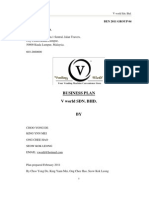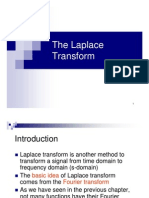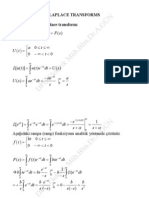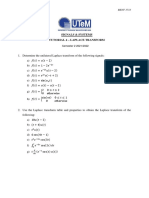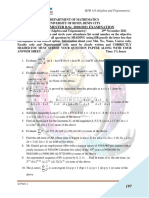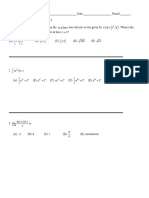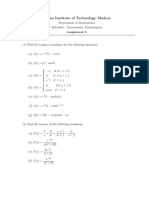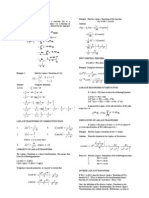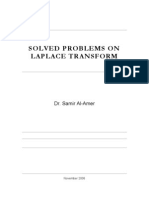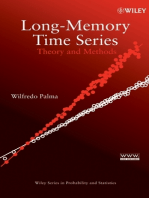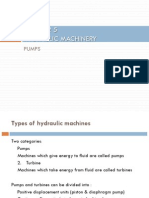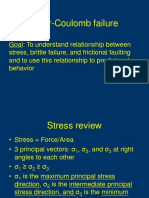Tutorial Chapter 3
Uploaded by
Ting Wee KietTutorial Chapter 3
Uploaded by
Ting Wee KietBUM2133 ORDINARY DIFFERENTIAL EQUATIONS
TUTORIAL 3: The Laplace Transform
1. Show from the definition of the Laplace transform that
(a) { }
2
1
2
+
=
s
e L
t
(b) { }
2 2
sin
a s
a
at L
+
=
2. Determine the Laplace transforms of the following functions.
(a) t t 6 5
3
+ (b)
3
) 1 ( + t
(c) t t 3 cos 7 4 sin 2 (d) at
2
cos
(e)
2
) cos (sin t t (f)
5 2
3 t t +
(g) t t 8 sin 8 cos (h) t e
t
4 sin 2
4
(i) t t cos
2
(j)
4 3
t e
t
(k) t e te t
t t
cos
4 3
+ (l) t e t e
t t
5 sin 2 3 cos 7
7 2
3. Find the Laplace transforms of the following functions.
(a)
at
te (b) t e
t
|
o
sin
(c) t e t t
t
3 sin 2 3
2
(d) t t t e
t
5 sin
2 3 2
+
(e)
t t
e t t e
2 2 2
3 cos
(f) t e e t
t t
7 cos
4 5
(g) t e te t
t t
cos
4 3
+ (h) t t 6 sin
4. Find the Laplace transform for the following function.
(a) { } ) 1 ( ] 6 ) 1 ( ) 1 [(
3
+ + t H t t L
(b) { } ) 3 ( ) 1 3 2 (
2
+ t H t t L
(c) { } ) 3 (
t H e L
t
(d) { } ) 2 ( ) 2 cos( t t t H t L
5. Find the inverse Laplace transform of
(a)
3
4
s
(b)
6
3
+ s
(c)
16
3
2
s
(d)
4
2
s
s
(e)
4
2 3
2
+
+
s
s
(f)
9
3 7
2
+
s
s
(g)
3
5
+ s
(h)
8 2
3
s
(i)
4 ) 1 (
6
2
+ + s
(j)
16 ) 3 (
1
2
+ +
+
s
s
(k)
2
1 2
+
+
s s
(l)
9
6
6
5
2
+
s
s
s
(m)
9
2
2
+
+
s
s
(n)
4
5 2
2
+
s
s
6. Find the inverse Laplace transform of
(a)
4
2
) 1 ( s
s
(b)
1 4 4
5 3
2
+ +
s s
s
(c)
5 4
13 8
2
+
+
s s
s
(d)
16 8 2
3 2
2
+
s s
s
(e)
16 ) 6 (
3
2
+ + s
(f)
5 4
1
2
+ + s s
(g)
1 ) 3 (
2
+ + s
s
(h)
1 2
6
2
+ +
s s
s
7. By using the second shift theorem, find the inverse Laplace transform of
(a)
2
2
s
e
s
(b)
3
4
) 2 ( +
s
e
s
(c)
4
2
+
s
se
s t
(d)
13 6
) 3 (
2
2
1
+
+
s s
e s
s t
8. Express the following expressions as partial fractions. Hence find their inverse
Laplace transforms.
(a)
) 1 (
1
s s
(b)
) 1 )( 1 (
1 2
2
2
+ +
+ +
s s
s s
(c)
) 4 )( 1 (
2 2
+ + s s
s
(d)
2 3
3
) 1 (
3 6 5
+
s s
s s
(e)
) 2 ( ) 1 (
6 3
2
2
+
+
s s
s
(f)
) 5 4 )( 2 (
3
2
+ + + s s s
(g)
) 2 2 )( 2 2 (
2 2
+ + + s s s s
s
(h)
) 2 2 ( ) 2 (
10 8
2 2
+ + +
+
s s s
s
(i)
) 3 )( 2 )( 1 (
26 23 5
2
+
s s s
s s
(k)
) 10 2 )( 2 (
1
2
+
s s s
s
9. Use the convolution theorem to determine the inverse Laplace transforms of
(a)
) 3 (
1
+ s s
(b)
) 2 (
4
2
s s
(c)
) 2 )( 3 (
1
+ s s
(d)
2 2 2
) ( a s
s
+
(e)
) 4 )( 1 (
2
+ s s
s
(f)
) 1 (
2
2 3
+ s s
10. Solve the following differential equations using Laplace transforms.
(a) 0 ) 0 ( = = + '
y e y y
t
(b) 1 ) 0 ( 2
2
= = + ' y t y y
(c)
2 1 2
2 2 ) 1 ( e
= = + ' e e y t y y
t
(d) 0 ) 0 ( cost = = ' y y y
(e) 1 ) 0 ( e
2
= = + '
y t y y
t
11. Solve the following differential equations using Laplace transforms.
(a) 1 ) 0 ( , 2 ) 0 ( 3 2
2
2
= ' = = + y y t y
dx
dy
dx
y d
(b) 0 ) 0 ( , 0 ) 0 ( sin 2
2
2
= ' = = y y t y
dx
dy
dx
y d
(c) 5 ) 0 ( , 0 ) 0 ( 4 4
2
2
2
= ' = = y y e y
dx
y d
t
(d) 2 ) 0 ( , 5 ) 0 ( 15 4
2
2
= ' = = + y y e y
dx
y d
t
12. Using Laplace Transform methods solve for 0 > t the following simultaneous
differential equations, subject to the given initial conditions. (Readers are encouraged
to check their solution using an appropriate software package).
(a)
t
e y
dt
dy
dt
dx
2
9 2 2
=
0 37 4 4 2 = + + y x
dt
dy
dt
dx
subject to 0 = x and
4
1
= y at 0 = t
(b) t y x
dt
dy
dt
dx
sin 5 2 = + +
t
e y x
dt
dy
dt
dx
= + + 3 2
subject to 0 = x and 0 = y at 0 = t
(c) x y
dt
x d
2
2
2
=
y x
dt
y d
2
2
2
=
subject to 4 = x , 2 = y , 0 =
dt
dx
and 0 =
dt
dy
at 0 = t
(d) 0 6 12 5
2
2
2
2
= + + x
dt
y d
dt
x d
0 6 16 5
2
2
2
2
= + + y
dt
y d
dt
x d
subject to
4
7
= x , 1 = y , 0 =
dt
dx
and 0 =
dt
dy
at 0 = t
(e) x y
dt
dy
dt
dx
dt
y d
dt
x d
9 3 2
2
2
2
2
=
x y
dt
dy
dt
dx
dt
y d
dt
x d
7 5 2
2
2
2
2
= + +
subject to 1 = =
dt
dx
x and 0 = =
dt
dy
y at 0 = t
Answer for Question 12
( )
(
+ =
=
t t t
t t
e e e t x
e e t y a
4
11
4
15
4
1
) (
8
1
8
3
) ( 12
3 2
3
( )
t t
t t
e t t e t x
t e e t y b
+ + =
+ =
sin 5 3 cos 5 ) (
sin 5 3 2 ) ( 12
2
2
( )
t t t x
t t t y c
3 cos cos 3 ) (
3 cos cos 3 ) ( 12
+ =
=
( )
t t t x
t t t y d
10
3
cos
8
3
6 cos
2
3
) (
10
3
cos
4
5
6 cos
4
1
) ( 12
=
+ =
( )
t
t
e t t t x
e t t t y e
3
1
2 sin
3
1
2 cos
3
2
) (
3
2
2 sin
3
1
2 cos
3
2
) ( 12
+ + =
+ =
You might also like
- Process Dynamics and Control, Ch. 3 Solution Manual100% (1)Process Dynamics and Control, Ch. 3 Solution Manual26 pages
- 2014 H2 Maths Prelim Papers - NJC P1 Solution0% (4)2014 H2 Maths Prelim Papers - NJC P1 Solution13 pages
- University of Cambridge Department of Chemical Engineering DatabookNo ratings yetUniversity of Cambridge Department of Chemical Engineering Databook40 pages
- Unit-VII Laplace Transforms: Properties of Laplace Transforms: L. Linearity Property: IfNo ratings yetUnit-VII Laplace Transforms: Properties of Laplace Transforms: L. Linearity Property: If21 pages
- "The Are Instructed by by The, by And, by ." - Cicero "A Man's Judgement Is No Better Than His Information." - From Bits & PiecesNo ratings yet"The Are Instructed by by The, by And, by ." - Cicero "A Man's Judgement Is No Better Than His Information." - From Bits & Pieces23 pages
- Engineering Mathematics Questions and Answers100% (1)Engineering Mathematics Questions and Answers9 pages
- Solucionário Livro Fundamentos de Circuitos Elétricos Sadiku 3 Edição - Capítulo 15No ratings yetSolucionário Livro Fundamentos de Circuitos Elétricos Sadiku 3 Edição - Capítulo 1574 pages
- Suggested Answer Scheme MAT 565/480 (Advanced Differential Equation) JANUARY 2012No ratings yetSuggested Answer Scheme MAT 565/480 (Advanced Differential Equation) JANUARY 20124 pages
- Unit V Laplace Transform Part - A: Problem 1 SolutionNo ratings yetUnit V Laplace Transform Part - A: Problem 1 Solution20 pages
- Edexcel C3 June 2005 To June 2011 All Questions Mark SchemeNo ratings yetEdexcel C3 June 2005 To June 2011 All Questions Mark Scheme44 pages
- Term End Examination - May 2013 Course: MAT101 - Multivariable Calculus and Differential Equations Slot: F2+TF2 Class NBR: 3461 Time: Three Hours Max - Marks:100No ratings yetTerm End Examination - May 2013 Course: MAT101 - Multivariable Calculus and Differential Equations Slot: F2+TF2 Class NBR: 3461 Time: Three Hours Max - Marks:1002 pages
- 2 Cosh 5 8 3 5: Willian Arroyo CI: 26.461.435No ratings yet2 Cosh 5 8 3 5: Willian Arroyo CI: 26.461.4357 pages
- Trigonometric Ratios to Transformations (Trigonometry) Mathematics E-Book For Public ExamsFrom EverandTrigonometric Ratios to Transformations (Trigonometry) Mathematics E-Book For Public Exams5/5 (1)
- Analytic Geometry: Graphic Solutions Using Matlab LanguageFrom EverandAnalytic Geometry: Graphic Solutions Using Matlab LanguageNo ratings yet
- 10+2 Level Mathematics For All Exams GMAT, GRE, CAT, SAT, ACT, IIT JEE, WBJEE, ISI, CMI, RMO, INMO, KVPY Etc.From Everand10+2 Level Mathematics For All Exams GMAT, GRE, CAT, SAT, ACT, IIT JEE, WBJEE, ISI, CMI, RMO, INMO, KVPY Etc.No ratings yet
- Mathematics 1St First Order Linear Differential Equations 2Nd Second Order Linear Differential Equations Laplace Fourier Bessel MathematicsFrom EverandMathematics 1St First Order Linear Differential Equations 2Nd Second Order Linear Differential Equations Laplace Fourier Bessel MathematicsNo ratings yet
- De Moiver's Theorem (Trigonometry) Mathematics Question BankFrom EverandDe Moiver's Theorem (Trigonometry) Mathematics Question BankNo ratings yet
- First Floor Cable Rating: Standard Applications Number Cable Specification (MM C.s.a.) Current Carrying in Conduit Voltage Drop (Mv/amp/m)No ratings yetFirst Floor Cable Rating: Standard Applications Number Cable Specification (MM C.s.a.) Current Carrying in Conduit Voltage Drop (Mv/amp/m)5 pages
- Slides 6 Dimensional Analysis and Hydraulic SimilarityNo ratings yetSlides 6 Dimensional Analysis and Hydraulic Similarity43 pages
- Mat201 Partial Differential Equations and Complex Analysis, December 2023No ratings yetMat201 Partial Differential Equations and Complex Analysis, December 20232 pages
- Crisostomo O. Retes National High School: General Mathematics Cycle 2No ratings yetCrisostomo O. Retes National High School: General Mathematics Cycle 215 pages
- 3 Smooth Maps: 3.1 Smooth Functions On ManifoldsNo ratings yet3 Smooth Maps: 3.1 Smooth Functions On Manifolds13 pages
- MTH 253 Calculus (Other Topics) : Chapter 10 - Section 10.0No ratings yetMTH 253 Calculus (Other Topics) : Chapter 10 - Section 10.0142 pages
- CBSE Solved Papers (2015-2020) by OP GuptaNo ratings yetCBSE Solved Papers (2015-2020) by OP Gupta659 pages
- Y Cot U: University of The City of ManilaNo ratings yetY Cot U: University of The City of Manila2 pages
- Module - 1 Vector Calculus: Lecture 2 - 26/10/21No ratings yetModule - 1 Vector Calculus: Lecture 2 - 26/10/2115 pages
- Form 4: Chapter 10 (Solution of Triangles) SPM Practice Fully-Worked SolutionsNo ratings yetForm 4: Chapter 10 (Solution of Triangles) SPM Practice Fully-Worked Solutions4 pages
- 12th-Maths-Chapter-11-Question-Paper-English-Medium-PDF-DownloadNo ratings yet12th-Maths-Chapter-11-Question-Paper-English-Medium-PDF-Download2 pages
- Process Dynamics and Control, Ch. 3 Solution ManualProcess Dynamics and Control, Ch. 3 Solution Manual
- University of Cambridge Department of Chemical Engineering DatabookUniversity of Cambridge Department of Chemical Engineering Databook
- Unit-VII Laplace Transforms: Properties of Laplace Transforms: L. Linearity Property: IfUnit-VII Laplace Transforms: Properties of Laplace Transforms: L. Linearity Property: If
- "The Are Instructed by by The, by And, by ." - Cicero "A Man's Judgement Is No Better Than His Information." - From Bits & Pieces"The Are Instructed by by The, by And, by ." - Cicero "A Man's Judgement Is No Better Than His Information." - From Bits & Pieces
- Solucionário Livro Fundamentos de Circuitos Elétricos Sadiku 3 Edição - Capítulo 15Solucionário Livro Fundamentos de Circuitos Elétricos Sadiku 3 Edição - Capítulo 15
- Suggested Answer Scheme MAT 565/480 (Advanced Differential Equation) JANUARY 2012Suggested Answer Scheme MAT 565/480 (Advanced Differential Equation) JANUARY 2012
- Unit V Laplace Transform Part - A: Problem 1 SolutionUnit V Laplace Transform Part - A: Problem 1 Solution
- Edexcel C3 June 2005 To June 2011 All Questions Mark SchemeEdexcel C3 June 2005 To June 2011 All Questions Mark Scheme
- Term End Examination - May 2013 Course: MAT101 - Multivariable Calculus and Differential Equations Slot: F2+TF2 Class NBR: 3461 Time: Three Hours Max - Marks:100Term End Examination - May 2013 Course: MAT101 - Multivariable Calculus and Differential Equations Slot: F2+TF2 Class NBR: 3461 Time: Three Hours Max - Marks:100
- Trigonometric Ratios to Transformations (Trigonometry) Mathematics E-Book For Public ExamsFrom EverandTrigonometric Ratios to Transformations (Trigonometry) Mathematics E-Book For Public Exams
- Analytic Geometry: Graphic Solutions Using Matlab LanguageFrom EverandAnalytic Geometry: Graphic Solutions Using Matlab Language
- Shortcuts to College Calculus Refreshment KitFrom EverandShortcuts to College Calculus Refreshment Kit
- 10+2 Level Mathematics For All Exams GMAT, GRE, CAT, SAT, ACT, IIT JEE, WBJEE, ISI, CMI, RMO, INMO, KVPY Etc.From Everand10+2 Level Mathematics For All Exams GMAT, GRE, CAT, SAT, ACT, IIT JEE, WBJEE, ISI, CMI, RMO, INMO, KVPY Etc.
- Mathematics 1St First Order Linear Differential Equations 2Nd Second Order Linear Differential Equations Laplace Fourier Bessel MathematicsFrom EverandMathematics 1St First Order Linear Differential Equations 2Nd Second Order Linear Differential Equations Laplace Fourier Bessel Mathematics
- Transformation of Axes (Geometry) Mathematics Question BankFrom EverandTransformation of Axes (Geometry) Mathematics Question Bank
- De Moiver's Theorem (Trigonometry) Mathematics Question BankFrom EverandDe Moiver's Theorem (Trigonometry) Mathematics Question Bank
- First Floor Cable Rating: Standard Applications Number Cable Specification (MM C.s.a.) Current Carrying in Conduit Voltage Drop (Mv/amp/m)First Floor Cable Rating: Standard Applications Number Cable Specification (MM C.s.a.) Current Carrying in Conduit Voltage Drop (Mv/amp/m)
- Slides 6 Dimensional Analysis and Hydraulic SimilaritySlides 6 Dimensional Analysis and Hydraulic Similarity
- Mat201 Partial Differential Equations and Complex Analysis, December 2023Mat201 Partial Differential Equations and Complex Analysis, December 2023
- Crisostomo O. Retes National High School: General Mathematics Cycle 2Crisostomo O. Retes National High School: General Mathematics Cycle 2
- MTH 253 Calculus (Other Topics) : Chapter 10 - Section 10.0MTH 253 Calculus (Other Topics) : Chapter 10 - Section 10.0
- Form 4: Chapter 10 (Solution of Triangles) SPM Practice Fully-Worked SolutionsForm 4: Chapter 10 (Solution of Triangles) SPM Practice Fully-Worked Solutions
- 12th-Maths-Chapter-11-Question-Paper-English-Medium-PDF-Download12th-Maths-Chapter-11-Question-Paper-English-Medium-PDF-Download





